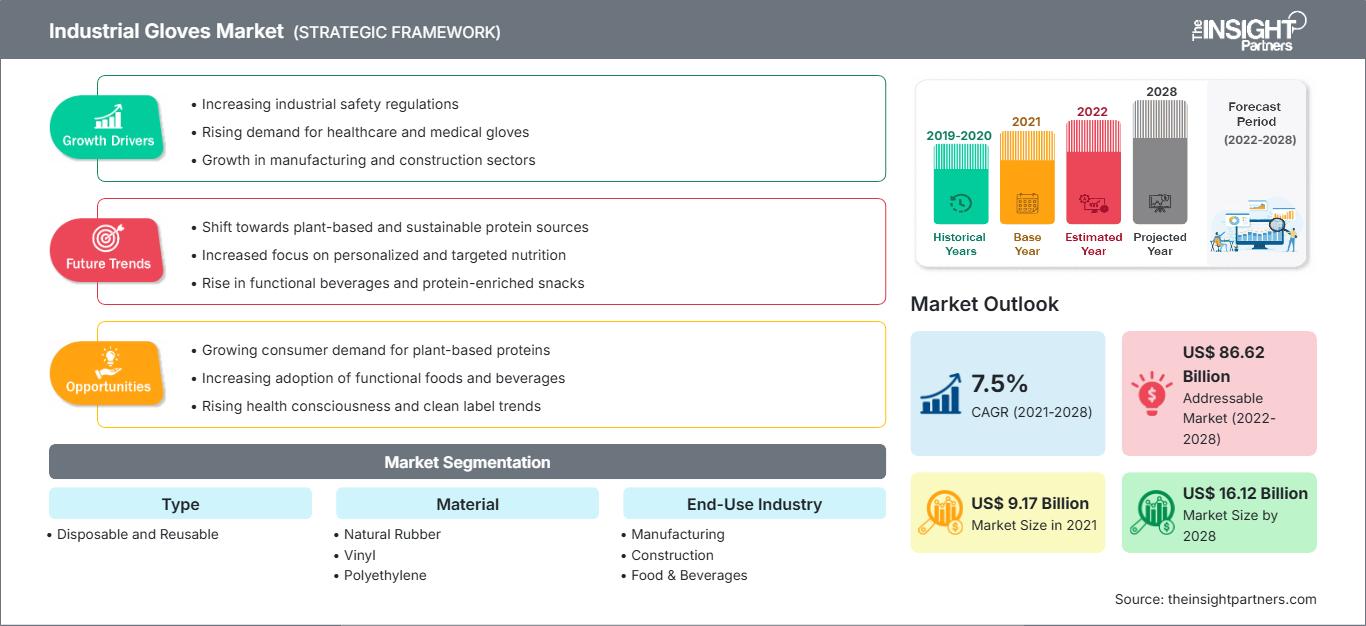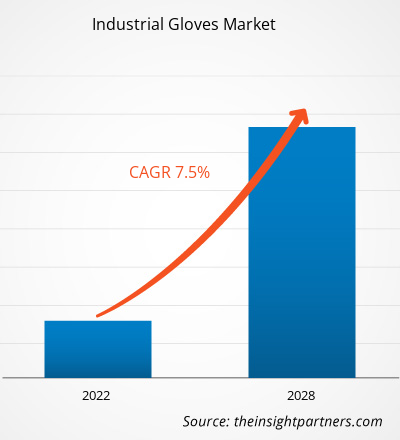[Rapport de recherche] Le marché des gants industriels était évalué à 9 174,06 millions de dollars américains en 2021 et devrait atteindre 16 119,54 millions de dollars américains d'ici 2028 ; il devrait croître à un TCAC de 7,5 % de 2021 à 2028.
Les gants industriels sont très utilisés dans différents secteurs tels que la fabrication, la construction, l'alimentation et les boissons, le pétrole et le gaz, la pharmacie, etc. Chaque secteur utilise son propre ensemble de normes et d'équipements de sécurité. Par conséquent, différentes industries nécessitent des gants différents.
En 2020, l'Asie-Pacifique détenait la plus grande part de chiffre d'affaires du marché mondial. La forte demande de gants provenant des secteurs de la fabrication, de l'alimentation et des boissons, de la construction et de la santé, entre autres, est le principal moteur de la croissance du marché des gants industriels en Asie-Pacifique. De plus, la région comprend des pays comme la Malaisie, la Thaïlande, l'Indonésie, l'Inde et la Chine, qui sont les principaux producteurs de caoutchouc. L'abondance de caoutchouc naturel fait de la région l'un des principaux producteurs de gants industriels. De plus, en Malaisie, l'industrie et le secteur du caoutchouc sont considérés comme des piliers essentiels de l'économie. L'industrie malaisienne du gant en caoutchouc bénéficie d'un soutien constant du gouvernement.
Vous bénéficierez d’une personnalisation sur n’importe quel rapport - gratuitement - y compris des parties de ce rapport, ou une analyse au niveau du pays, un pack de données Excel, ainsi que de profiter d’offres exceptionnelles et de réductions pour les start-ups et les universités
Marché des gants industriels: Perspectives stratégiques

-
Obtenez les principales tendances clés du marché de ce rapport.Cet échantillon GRATUIT comprendra une analyse de données, allant des tendances du marché aux estimations et prévisions.
Impact de la pandémie de COVID-19 sur le marché des gants industriels
La pandémie de COVID-19 a affecté les économies et les industries de divers pays en raison des confinements, des interdictions de voyager et des fermetures d'entreprises. En 2020, plusieurs industries ont dû ralentir leurs opérations en raison des perturbations des chaînes de valeur causées par la fermeture des frontières nationales et internationales, ce qui a entraîné une faible demande de gants industriels de la part de diverses industries. La pandémie de COVID-19 a provoqué une volatilité des prix des matières premières nécessaires à la production de gants industriels. La consommation mondiale de gants industriels a diminué en raison de la faible demande de divers secteurs tels que la construction et l'industrie manufacturière. La baisse de la demande de diverses industries due à la pandémie de COVID-19 a eu un impact négatif sur la croissance du marché des gants industriels. Cependant, l'apparition de la COVID-19 a accru la demande d'équipements de protection individuelle (EPI), notamment de gants, dans le secteur de la santé.
Aperçu du marché
Utilisation croissante des gants dans divers secteurs
Les blessures à la main sont l'une des blessures les plus courantes sur le lieu de travail. Elles peuvent être évitées grâce à l'utilisation d'équipements de protection individuelle (EPI), tels que les gants. Le principal facteur à l'origine de la demande pour différents équipements de protection individuelle, notamment les gants, est la sensibilisation accrue à la sécurité sur le lieu de travail.
Les gants offrent une protection contre les produits chimiques et autres liquides dangereux dans les industries chimiques. Ils sont également utilisés lorsque les travailleurs sont confrontés à de l'huile et d'autres lubrifiants. Comme les gants offrent une excellente isolation contre les températures élevées, les gants résistants à la température sont largement utilisés dans le soudage, le traitement des métaux, le forgeage et les opérations connexes. Par conséquent, le respect croissant des procédures de sécurité, ainsi que les multiples avantages des gants, entraînent leur application croissante dans différents secteurs.
Aperçu des types
En fonction du type, le marché mondial est segmenté en jetables et réutilisables. Le segment jetable détenait une part plus importante du marché mondial en 2020. Les gants jetables sont développés à partir de différents matériaux, notamment le nitrile, le caoutchouc naturel, le néoprène et le vinyle. Les gants jetables sont utilisés dans divers secteurs, notamment le pétrole et le gaz, l'agroalimentaire, la construction, la santé et la chimie.
Marché des gants industriels, par type - 2020 et 2028
En fonction de l'industrie d'utilisation finale, le marché est segmenté en fabrication, construction, agroalimentaire, pétrole et gaz, pharmaceutique, etc. Le secteur manufacturier détenait la plus grande part du marché mondial en 2020. Dans ce secteur, les gants industriels sont très utilisés, notamment pour la production de machines lourdes nécessitant des gants industriels pour des raisons de sécurité. L'augmentation des effectifs et la présence de main-d'œuvre dans les industries manufacturières ont entraîné une hausse de la demande mondiale de gants industriels.
3M ; Ansell Limited ; Carolina Glove & Safety Company ; Cementex Products, Inc. ; Cintas Corporation ; Honeywell International Inc. ; International Plastics Inc. ; Southern Glove, Inc. ; Superior Glove ; et Workwear Outfitters, LLC comptent parmi les principaux acteurs du marché mondial des gants industriels. Ces acteurs privilégient constamment des stratégies telles que les investissements en recherche et développement et le lancement de nouveaux produits. Ils s'attachent à développer des offres de produits innovantes et de haute qualité pour répondre aux exigences des clients.
Marché des gants industriels
Les tendances régionales et les facteurs influençant le marché des gants industriels tout au long de la période de prévision ont été analysés en détail par les analystes de The Insight Partners. Cette section aborde également les segments et la géographie du marché des gants industriels en Amérique du Nord, en Europe, en Asie-Pacifique, au Moyen-Orient et en Afrique, ainsi qu'en Amérique du Sud et en Amérique centrale.
Portée du rapport sur le marché des gants industriels| Attribut de rapport | Détails |
|---|---|
| Taille du marché en 2021 | US$ 9.17 Billion |
| Taille du marché par 2028 | US$ 16.12 Billion |
| TCAC mondial (2021 - 2028) | 7.5% |
| Données historiques | 2019-2020 |
| Période de prévision | 2022-2028 |
| Segments couverts |
By Type
|
| Régions et pays couverts |
Amérique du Nord
|
| Leaders du marché et profils d'entreprises clés |
|
Densité des acteurs du marché des gants industriels : comprendre son impact sur la dynamique des entreprises
Le marché des gants industriels connaît une croissance rapide, portée par une demande croissante des utilisateurs finaux, due à des facteurs tels que l'évolution des préférences des consommateurs, les avancées technologiques et une meilleure connaissance des avantages du produit. Face à cette demande croissante, les entreprises élargissent leur offre, innovent pour répondre aux besoins des consommateurs et capitalisent sur les nouvelles tendances, ce qui alimente la croissance du marché.
- Obtenez le Marché des gants industriels Aperçu des principaux acteurs clés
Points forts du rapport
- Tendances progressives du marché des gants industriels pour aider les acteurs à développer des stratégies efficaces à long terme
- Stratégies de croissance des entreprises adoptées par les marchés développés et en développement
- Analyse quantitative du marché des gants industriels de 2019 à 2028
- Estimation de la demande mondiale de gants industriels
- Analyse des cinq forces de Porter pour illustrer l'efficacité des acheteurs et des fournisseurs opérant dans le secteur
- Évolutions récentes pour comprendre le scénario concurrentiel du marché
- Tendances et perspectives du marché ainsi que facteurs stimulant et freinant la croissance du marché des gants industriels
- Aide à la prise de décision en mettant en évidence les stratégies de marché qui sous-tendent l'intérêt commercial, conduisant à la croissance du marché
- Taille du marché des gants industriels à différents nœuds
- Aperçu détaillé et segmentation du marché, ainsi que de l'industrie des gants industriels dynamique
- Taille du marché des gants industriels dans diverses régions avec des opportunités de croissance prometteuses
Marché mondial des gants industriels
Type
- Jetable
- Réutilisable
Matériau
- Naturel Caoutchouc
- Vinyle
- Polyéthylène
- Nitrile
- Autres
Industrie d'utilisation finale
- Industrie manufacturière
- Construction
- Alimentaire et amp; Boissons
- Huile etamp; Gaz
- Pharmaceutique
- Autres
Profils d'entreprise
- 3M
- Ansell Limited
- Carolina Glove & Safety Company
- Cementex Products, Inc.
- Cintas Corporation
- Honeywell International Inc.
- International Plastics Inc.
- Southern Glove, Inc.
- Superior Glove
- Workwear Outfitters, LLC
- Analyse historique (2 ans), année de base, prévision (7 ans) avec TCAC
- Analyse PEST et SWOT
- Taille du marché Valeur / Volume - Mondial, Régional, Pays
- Industrie et paysage concurrentiel
- Ensemble de données Excel
Rapports récents
Témoignages
Raison d'acheter
- Prise de décision éclairée
- Compréhension de la dynamique du marché
- Analyse concurrentielle
- Connaissances clients
- Prévisions de marché
- Atténuation des risques
- Planification stratégique
- Justification des investissements
- Identification des marchés émergents
- Amélioration des stratégies marketing
- Amélioration de l'efficacité opérationnelle
- Alignement sur les tendances réglementaires






















 Obtenez un échantillon gratuit pour - Marché des gants industriels
Obtenez un échantillon gratuit pour - Marché des gants industriels